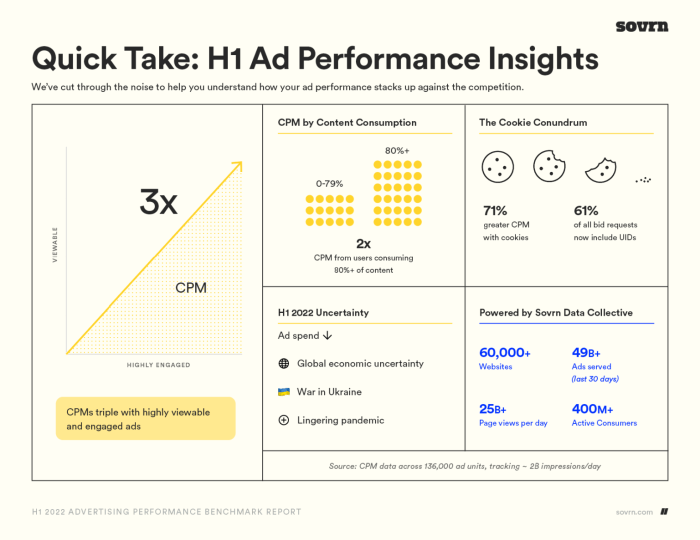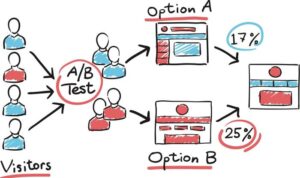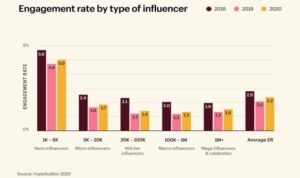Using Data to Improve Ad Performance sets the stage for transforming your ad game with powerful data-driven strategies, unlocking the secrets to maximizing your ad impact and reaching your target audience with precision. Dive into the world of ad optimization and discover how data can revolutionize your marketing approach.
Importance of Data in Ad Performance Improvement: Using Data To Improve Ad Performance
Data is a crucial element in enhancing ad performance as it provides valuable insights into the effectiveness of advertising campaigns. By analyzing various data metrics, marketers can make informed decisions to optimize their ad strategies and maximize ROI.
Key Data Metrics for Measuring Ad Performance
- Click-Through Rate (CTR): This metric measures the percentage of people who click on an ad after seeing it. A high CTR indicates that the ad is engaging and relevant to the target audience.
- Conversion Rate: The conversion rate shows the percentage of users who take a desired action after clicking on an ad, such as making a purchase or signing up for a newsletter.
- Cost Per Acquisition (CPA): CPA calculates the cost of acquiring a customer through advertising. Lower CPA indicates more cost-effective ad campaigns.
- Return on Ad Spend (ROAS): ROAS measures the revenue generated for every dollar spent on advertising. A higher ROAS signifies a more profitable ad campaign.
Impact of Data-Driven Decisions on Ad Effectiveness, Using Data to Improve Ad Performance
Data-driven decisions have a significant impact on ad effectiveness by enabling marketers to tailor their strategies based on real-time insights. By analyzing data, marketers can identify trends, consumer behavior patterns, and preferences, allowing them to create more targeted and personalized ad campaigns. This results in higher engagement, conversion rates, and overall return on investment for advertising efforts.
Types of Data Utilized for Ad Performance Enhancement
Data plays a crucial role in optimizing ad performance by providing valuable insights into audience behavior, preferences, and engagement. There are various types of data sources that marketers leverage to enhance the effectiveness of their ad campaigns.
First-Party Data vs. Third-Party Data
First-party data refers to information collected directly from customers or users, such as website interactions, purchase history, or demographic details. This data is highly valuable as it is specific to the brand’s audience and can provide personalized targeting options. On the other hand, third-party data is obtained from external sources, such as data providers or publishers. While third-party data can offer broader insights and reach, it may lack the depth and accuracy of first-party data.
- First-Party Data:
- Highly specific to the brand’s audience.
- Provides personalized targeting options.
- Offers valuable insights based on direct interactions.
- Third-Party Data:
- Obtained from external sources.
- Can offer broader reach and insights.
- May lack the depth and accuracy of first-party data.
Utilizing a combination of first-party and third-party data can help marketers create more comprehensive targeting strategies and improve ad performance.
Significance of Real-Time Data
Real-time data refers to information that is collected and analyzed instantaneously, allowing marketers to make timely adjustments to their ad campaigns based on current trends and user behavior. By leveraging real-time data, marketers can optimize targeting, messaging, and budget allocation to maximize the impact of their ads.
- Allows for immediate adjustments to ad campaigns.
- Enables real-time optimization of targeting and messaging.
- Helps in maximizing ad performance based on current trends.
Implementing Data Analysis Tools for Ad Optimization

Data analysis tools play a crucial role in optimizing ad performance for marketers. By utilizing these tools, marketers can gain valuable insights into their target audience, ad effectiveness, and overall campaign performance. Let’s delve into some popular data analysis tools used by marketers and how they are integrated into ad campaigns to drive success.
Google Analytics
Google Analytics is one of the most widely used data analysis tools by marketers. It provides detailed information about website traffic, user behavior, and conversion rates. By integrating Google Analytics into ad campaigns, marketers can track the performance of their ads, identify key metrics, and make data-driven decisions to optimize their campaigns.
Facebook Ads Manager
Facebook Ads Manager is another powerful data analysis tool that allows marketers to track the performance of their Facebook ad campaigns. Marketers can analyze metrics such as reach, engagement, and conversion rates to understand the effectiveness of their ads. By leveraging the insights provided by Facebook Ads Manager, marketers can make adjustments to their ad campaigns to improve performance.
Adobe Analytics
Adobe Analytics is a comprehensive data analysis tool that provides marketers with in-depth insights into customer behavior, campaign performance, and ROI. By integrating Adobe Analytics into ad campaigns, marketers can track the entire customer journey, from ad click to conversion. This allows marketers to optimize their ad campaigns for maximum impact and ROI.
Successful Examples
One successful example of ad campaign optimization through data analysis tools is Coca-Cola’s “Share a Coke” campaign. By leveraging data analysis tools such as Google Analytics and social media analytics, Coca-Cola was able to personalize their ads based on customer preferences and behavior. This resulted in a significant increase in engagement and sales for the brand.
In conclusion, data analysis tools are essential for marketers looking to optimize their ad campaigns for success. By utilizing tools such as Google Analytics, Facebook Ads Manager, and Adobe Analytics, marketers can gain valuable insights, track performance metrics, and make data-driven decisions to improve ad performance and drive results.
Strategies for Leveraging Data to Improve Ad Performance

Utilizing data effectively is crucial in improving ad performance. By implementing the right strategies, businesses can enhance ad targeting, personalize campaigns, and optimize creatives based on valuable insights.
Best Practices for Utilizing Data to Enhance Ad Targeting and Personalization
- Segment your audience based on demographics, behavior, and interests to tailor ad content accordingly.
- Utilize retargeting techniques to reach users who have shown interest in your products or services.
- Implement dynamic ads that automatically adjust content based on user interactions and preferences.
- Regularly analyze and refine your targeting strategies based on performance metrics to ensure maximum effectiveness.
Explain How A/B Testing Can Be Utilized to Optimize Ad Creatives Based on Data Insights
A/B testing involves comparing two versions of an ad to determine which performs better. By testing variables such as copy, visuals, and call-to-action buttons, businesses can gather data-driven insights to optimize ad creatives for maximum impact.
Discuss the Role of Predictive Analytics in Predicting Ad Performance and Optimizing Campaigns
Predictive analytics uses historical data and statistical algorithms to forecast future outcomes. In the context of ad performance, predictive analytics can help businesses anticipate how ads will perform, identify trends, and optimize campaigns for better results. By leveraging predictive analytics, businesses can make data-driven decisions to improve ad performance and achieve their marketing goals.





